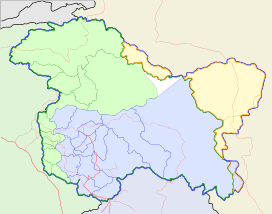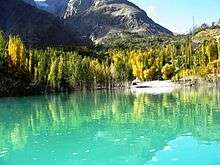Gulmit
| Gulmit | |
|---|---|
| Town | |
|
The 7,500 metre tall Passu Sar mountain overlooks the city | |
 Gulmit | |
| Coordinates: 36°23′21″N 74°51′54″E / 36.3891°N 74.8651°ECoordinates: 36°23′21″N 74°51′54″E / 36.3891°N 74.8651°E | |
| Country |
|
| Province | Gilgit–Baltistan |
| District | Hunza |
| Tehsil | Gojal |
| Elevation | 2,465 m (8,087 ft) |
| Population (2016) | |
| • Total | more than 5,000 |
| Time zone | PST (UTC+5) |
| Climate | BWk |
Gulmit (Wakhi/Urdu: گلمیت) aka Gul-e-Gulmit is the headquarters of the Gojal Tehsil, in the Gilgit-Baltistan region of Pakistan. Gulmit is a centuries-old historic town, with mountains, peaks and glaciers. It is a tourist spot and has many hotels, shops and a museum. Small hamlets consist of Kamaris, Odver, Dalgiram, Laksh, Kalha, Shawaran, Khor Laksh, Chamangul and Goze.
Gulmit, the locals say, means "the land of flowers".

History
Before 1974, when Hunza was a state, Gulmit used to be the Summer Capital of the state. After the abolition of the state it became the Tehsil's seat of government. The oldest intact house in Gulmit is more than six centuries old. Most of People in the entire Gojal Valley have Central Asian ancestral backgrounds. The people speak Wakhi language and belong to the Shia Imami Ismaili sect of Islam. Population of Gulmit, according to 2016 survey, consists of around 5000 individuals. fifty one percent of the population comprises females There are many forts and fortresses in Gojal valley, such as Qalanderchi fort in Misghar valley and Rashit fort in Chipursan valley. But Ondra fort is the most prominent. This fort is perched on Ondra hill, which overlooks Gulmit and Ghulkin villages. The fort is believed to have been built by one Qutlug Baig in the 16th century. He was the first Wakhi ruler to establish rule in Gulmit, threatening the Mirs of Hunza. Before him, Gulmit was under the control of Hazur Jamshid (1550-1556), who was the ruler of Gilgit. His sons Su Malik and Mir Malik were deputed to collect the tax from Gojal. Once, returning from a visit to collect tax from Yishkook in Chipursan valley, the two stopped in Gulmit and liked it. They decided to live in Gulmit. After the death of Hazur Jamshid, Su Malik, the elder son, rushed to Gilgit to sit on his father's throne. He became the new ruler of Gilgit (1556-1578). According to Muhammad Zia, celebrated genealogy-keeper (zon) of Gulmit, Mir Malik also eventually left for Hunza. Taking advantage of the absence of Su Malik and Mir Malik, Qutlug Baig with the help of locals captured Gulmit and the surrounding villages. Qutlug Baig belonged to the Charshambi Kator lineage of the Wakhis of Gulmit.
The territory of Qutlug Baig started from Khyber village and ended at Chaman Gul. In order to secure his territory from invaders, he built two gates, one at Khyber and the other at Chaman Gul. The gates were closed at night and opened during the day. In wartime, these gates remained closed, thus keeping the enemies away from his dominion. The remains of both gates and fortification walls can still be seen at Khyber as well as in Chaman Gul.
In order to rein in the probable advance of the enemies from North and south, Quitlug Baig built the Ondra fort. To the north lay the State of Hunza, and to the South the power of Kirghiz invaders who used to attack Gulmit to control the pastures for their livestock. The height of the fort's ramparts ranges from 6 to 13 feet above the ground. There were many living quarters inside the fort. One can still find them at two places, one on the southern side and the other on the northern side. These living quarters were separated by a central wall of the fort that runs east-west. The central rampart is higher than the southern and northern fortification walls. The northern quarters were constructed for the army of Qutlug to keep an eye on the enemy advancing from the north, while the southern quarters were built to keep check on the enemy coming from the south, particularly the army of the Mir of Hunza. The fortification walls have been provided embrasure and merlons. Only the northern and southern fortification walls have been provided embrasure. All the ramparts of the fort are still in a good condition. However, the eastern and western fortification walls are in a crumbling condition.
In order to secure his territory from invaders, he built two gates which were closed at night and opened during the day The Ondra fort reflects the power of the Wakhi ruler Qutlug who was never defeated by the Mirs of Hunza. He was famous for his gallantry and swordsmanship in the battlefield. Mirs of Hunza were scared by the rising power of Qutlug. They never dared to cross his territory. Qutlug was poisoned to death by one of his elderly female servants. She was sent by then Mir of Hunza Mir Malik. She admisntered poison in the food of Qutlug and his courtesans. After the death of Qutllug, Gulmit was recaptured and Ondra fell into hands of the Mir of Hunza. Qutlug Baig was buried in Gulmit along with his courtesans. According to Afzal Khan, one of the notables of Gulmit, the grave of Qutlug was located where there is now the Government Girls High School in Gulmit. Qutllug ruled over Gulmit and its adjoining areas for twelve years. During his rule, land and life was safe and secure. He pushed the advancing Kirghiz back to their land and never let them succeed in their mission and goals. The heroic stories of Qulug still dominate the daily discourse of the Wakhi people living in Gulmit, Shimshal, Chipursan, the valleys of Gojal. Many storytellers still amuse both audience and themselves by narrating the stories of their ruler Qutlug Baig. This fort is still a destination for domestic and international tourists. From Ondra fort one has a panoramic view of Gulmit. From the south one can see Gulmit and as far as Shishkat villages and from the north one can view the Ghulkin village. From the north one can enjoy seeing Ghulkin glacier, the passu cones and Qaroon peak. From the west, there are amazing views of Gulmit Glacier, Gulmit Tower, Shisper Peak and Utlar Sar. And from the east there is a spectacular view of the Hunza River.
Climate
With virtually no rainfall during the year, Gulmit features a cold desert climate (BWk) under the Köppen climate classification. The average temperature in Gulmit is 25 to 30°C, while the annual precipitation averages 113 mm. November is the driest month with 2 mm of rainfall, while May, the wettest month, has an average precipitation of 24 mm.
July is the warmest month of the year with an average temperature of 21.8 °C. The coldest month January has an average temperature of -10 °C.
| Climate data for Gulmit | |||||||||||||
|---|---|---|---|---|---|---|---|---|---|---|---|---|---|
| Month | Jan | Feb | Mar | Apr | May | Jun | Jul | Aug | Sep | Oct | Nov | Dec | Year |
| Average high °C (°F) | −1.0 (30.2) |
1.5 (34.7) |
7.6 (45.7) |
14.7 (58.5) |
19.9 (67.8) |
25.4 (77.7) |
28.5 (83.3) |
30.0 (86) |
23.0 (73.4) |
16.3 (61.3) |
9.1 (48.4) |
−1.5 (29.3) |
14.46 (58.03) |
| Daily mean °C (°F) | −5.5 (22.1) |
−3.2 (26.2) |
2.9 (37.2) |
9.4 (48.9) |
13.9 (57) |
18.8 (65.8) |
21.8 (71.2) |
21.5 (70.7) |
16.6 (61.9) |
10.0 (50) |
3.5 (38.3) |
−2.5 (27.5) |
8.93 (48.07) |
| Average low °C (°F) | −10.0 (14) |
−7.9 (17.8) |
−1.7 (28.9) |
4.1 (39.4) |
7.9 (46.2) |
12.3 (54.1) |
15.2 (59.4) |
15.1 (59.2) |
10.2 (50.4) |
3.8 (38.8) |
−2.1 (28.2) |
−6.8 (19.8) |
3.34 (38.02) |
| Source: Climate-Data.org[1] | |||||||||||||
Buildings
There are five Jamaat-khanas or religious community centres in Gulmit. One notices their presence in every ward of the village. The old Summer Palace of Mir of Hunza stands at the northern edge of Gulmit's historic Polo Ground. Old places of worship, now used as libraries, also adorn the beautiful physique of Gulmit valley.
Among new buildings constructed by the government in Gulmit are Tehsil Headquarters, Federal Government's Boys High School, Civil Hospital, Diamond Jubilee Girls Middle School and Government Girls Higher Secondary School.
Al- Amyn Model School, a community-based organization, has a beautiful building standing next to the Health Center of Aga Khan Health Services.
Hotels
There are a number of well furnished hotels in Gulmit valley. The hotels in Gulmit listed in order of preference and popularity are Silk Route Lodge, Marco Polo Hotel, Village Guest House, Gulmit Tourist Inn, Gulmit Continental hotel and Horse Shoe Motel.
Personalities
- Nazir Ahmad Bulbul: The most prominent poet of Wakhi language, Nazir Ahmad Bulbul, was born and lives in Gulmit.
- Group Captain Shah Khan of the Gilgit Scouts liberation army was one of the prominent personalty of this town.
- Shah Gul Aziz: Shah Gul Aziz was one of the finest players of Polo. He played for Gilgit Police, NLI and other teams at Shandur. His 5 goals in 6 minutes in Shandur is still an unbroken record in the history of polo games.
- Qurban Jan: Qurban Jan is the first person from Hunza to successfully qualify the Government of Pakistan's Services Exams and served in various Government departments with integrity for over 40 years before he retired.
- Mutabiat Shah: Mutabiat Shah is the first Wakhi speaking person from Hunza to represent Hunza/Gojal in any Legislative assembly in Gilgit-Baltistan. He served as Technocrat member of the Giglit-Balistan Legislative Assembly from 2009 to 2014.
- Pervaiz Ahmad participated in the World Winter Special Olympic Games 2017, and won three silver medals for Pakistan. He belongs to Gulmit.
Mountains
Gulmit is surrounded by mountains from all sides. To the extreme north is Tupopodon, while on the South is Ghawush. Standing tall in the East is Mount Pulpul, and in the West is Gulmit Tower, right above the Shutubar Glacier. Gulmit Tower, a vertical monolith, is yet to be climbed.
Village organizations
There are as many as 26 registered organizations working wholehearted for betterment of the village. Most of these organizations work under the umbrella of Gulmit Organization for Local Development (GOLD). Some of the larger organizations, member-wise and activities-wise are the following:
- Gulmit Educational and Social Welfare Society (GESW)
- Gulmit Organization for Local Development (GOLD)
- Counselling and Management Body Gulmit (CMBG)
- Gulmit Arts Council
- Gulmit Natural Resources Conservation Group
- Rituals Committee
- Bulbulik
Apart from these social organizations there are other Ismaili organizations, working under the banner of the Shia Immami Ismaila Council for Gulmit. These Ismaili organizations cater services to the entire Gojal Valley but Gulmit, being the headquarters, hosts their offices.
See also
External links
References
- ↑ "Climate: Gulmit - Climate-Data.org". Retrieved 9 September 2016.
